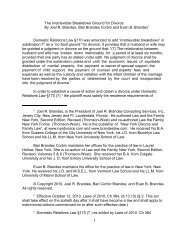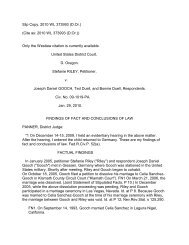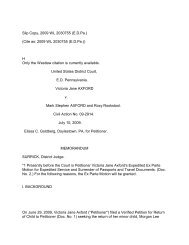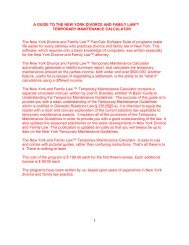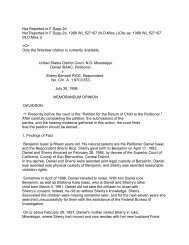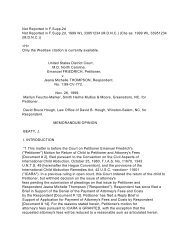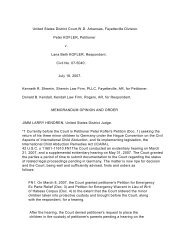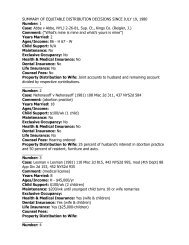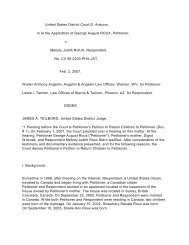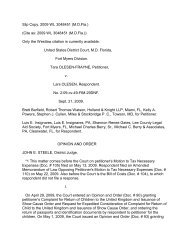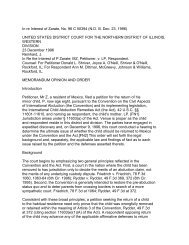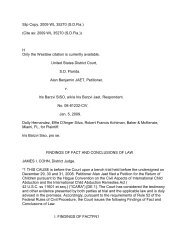Sita-Mambwene v. Keeton
Sita-Mambwene v. Keeton
Sita-Mambwene v. Keeton
Create successful ePaper yourself
Turn your PDF publications into a flip-book with our unique Google optimized e-Paper software.
Slip Copy, 2009 WL 2836430 (E.D.Mo.)<br />
(Cite as: 2009 WL 2836430 (E.D.Mo.))<br />
Only the Westlaw citation is currently available.<br />
United States District Court,<br />
E.D. Missouri,<br />
Eastern Division.<br />
Mireille SITA-MAMBWENE, Petitioner,<br />
v.<br />
Anthony Eugin KEETON, Respondent.<br />
No. 4:09CV00913 ERW.<br />
Aug. 28, 2009.<br />
Christopher J. Schmidt, Brent E. Roam, Louis J. Boyd, Bryan Cave LLP, St. Louis, MO,<br />
for Petitioner.<br />
Allan F. Stewart, Stewart and Mittleman, St. Louis, MO, for Respondent.<br />
MEMORANDUM AND ORDER<br />
E. RICHARD WEBBER, District Judge.<br />
*1 This matter comes before the Court on Petitioner Mireille <strong>Sita</strong>-<strong>Mambwene</strong>'s<br />
Verified Petition for Return of Children under the Hague Convention [doc. # 1].<br />
On June 11, 2009, Petitioner Mireille <strong>Sita</strong>-<strong>Mambwene</strong> ("Petitioner") filed the pending<br />
Petition with this Court. Petitioner alleges that Respondent Anthony Eugin <strong>Keeton</strong><br />
("Respondent") wrongfully removed their three minor children FN1 from Germany,<br />
which she asserts is their place of habitual residence, in March 2008.<br />
Thus, Petitioner seeks relief from this Court under the Hague Convention.<br />
Specifically, Petitioner seeks an Order from this Court, requiring the return of the<br />
children to Germany and to Petitioner. Respondent opposes Petitioner's requested<br />
relief, and asserts various affirmative defenses in support of his arguments.<br />
FN1. Petitioner and Respondent have three children together, P.K. (age 10),
S.K. (age 9), and J.K. (age 7).<br />
I. WRONGFUL REMOVAL UNDER THE HAGUE CONVENTION<br />
In 1980, a group of countries participated in and adopted the Hague Convention on<br />
the Civil Aspects of International Child Abduction ("the Convention"). Although the<br />
United States did not participate in the actual proceedings, it ratified the Convention in<br />
1988, by enacting the International Child Abduction Remedies Act ("ICARA"). 42 U.S.C.<br />
s 11601-11611 (1988). The stated purpose of the Convention was "to secure the<br />
prompt return of children wrongfully removed to or retained in any Contracting State;<br />
and to ensure that rights of custody and of access under the law of one Contracting<br />
State are effectively respected in the other Contracting States." Hague Convention on<br />
the Civil Aspects of International Child Abduction art. 1, Oct. 25, 1990, 19 I.L.M. 1501.<br />
In carrying out this stated purpose, the Convention provides for the return of a child<br />
who has been "wrongfully removed" from the country in which he or she is a habitual<br />
resident.<br />
Id. arts. 3, 12. The removal of a child is considered to be "wrongful" when it is in breach<br />
of the custody rights of another person and when those custodial rights were actually<br />
being exercised at the time of the removal, or would have been exercised but for the<br />
removal. Custodial rights, and any breach thereof, are determined under the law of the<br />
country that is determined to be the child's habitual residence.FN2 Id. art. 3.<br />
FN2. The Convention distinguishes between "rights of custody" and "rights of<br />
access." The former refers to the "rights relating to the care of the person<br />
of the child," and specifically requires the person asserting custody to<br />
possess "the right to determine the child's place of residence." The latter,<br />
however, refers to "the right to take the child for a limited period of time<br />
to a place other than the child's habitual residence." Id. art. 5. Rights<br />
of custody are assigned greater protection under the Convention than are<br />
rights of access; the Convention provides for the return of the child to his<br />
or her habitual residence in cases involving rights of custody, but in cases<br />
involving rights of access, the Convention only requires a country to take<br />
"steps to remove, as far as possible, all obstacles to the exercise of such<br />
rights." Id. arts. 12, 21; see Gonzalez v. Gutierrez, 311 F.3d 942, 948-49<br />
(9th Cir.2002).<br />
As noted by the Eighth Circuit, "[t]he key inquiry under the Convention is whether a<br />
child has been wrongfully removed from the country of its habitual residence or<br />
wrongfully retained in a country other than that of its habitual residence." Barzilay v.<br />
Barzilay, 536 F.3d 844, 847 (8th Cir.2008). In determining whether a child was<br />
wrongfully removed under the Convention, a court is to address a series of four<br />
questions, initially set forth by the Ninth Circuit and subsequently adopted by many<br />
other courts, including the Eighth Circuit. These questions are:<br />
(1) When did the removal or retention at issue take place? (2) Immediately prior to the
emoval or retention, in which state was the child habitually resident?<br />
(3) Did the removal or retention breach the rights of custody attributed to the petitioner<br />
under the law of the habitual residence? (4) Was the petitioner exercising those rights<br />
at the time of the removal or retention?<br />
*2 Mozes v. Mozes, 239 F.3d 1067, 1070 (9th Cir.2001); see also Barzilay, 536 F.3d<br />
at 847. The Court will address these issues in the sections that follow.<br />
Finally, it is important to note that "[a] case arising from a petition under the Hague<br />
Convention is not a custody proceeding. A United States district court 'has authority to<br />
determine the merits of an abduction claim, but not the merits of the underlying custody<br />
claim.' " Barzilay, 536 F.3d at 847 (quoting Shalit v.<br />
Coppe, 182 F.3d 1124, 1128 (9th Cir.1999)).<br />
A. TIME OF REMOVAL<br />
The issue of when the alleged wrongful removal took place is not disputed in this<br />
case. It is clear that the removal at issue occurred on or about March 1, 2008, when<br />
Respondent left Germany with the three minor children and came to the United States.<br />
B. PLACE OF HABITUAL RESIDENCE<br />
The Court must now determine where the children were habitually residing<br />
immediately prior to the alleged wrongful removal. Although the Convention places<br />
great significance on the place of the child's habitual residence, it does not provide a<br />
precise definition or explanation of what is meant by the term. See Mozes, 239 F.3d at<br />
1071. The Convention does, however, establish that the only relevant point in time for<br />
determining habitual residence is "immediately before the removal or retention."<br />
Silverman v. Silverman, 338 F.3d 886, 897 (8th<br />
Cir.2003) (en banc) (citing Hague Convention on the Civil Aspects of International Child<br />
Abduction art. 3, Oct. 25, 1990, 19 I.L.M. 1501). Beyond the minimal guidance provided<br />
by the Convention, the Eighth Circuit has recognized that<br />
"[a] person may have only one habitual residence and it should not be confused with<br />
domicile. [T]he court must focus on the child, not the parents, and examine past<br />
experience, not future intentions. Habitual residence may only be altered by a change<br />
in geography and passage of time."<br />
"Federal courts are agreed that habitual residence must encompass some form of<br />
settled purpose. The settled purpose need not be to stay in a new location forever, but<br />
the family must have a sufficient degree of continuity to be properly described as<br />
settled."<br />
Sorenson v. Sorenson, 559 F.3d 871, 873 (8th Cir.2009) (quoting Silverman,<br />
338 F.3d at 898) (alterations in original and citations omitted).
The Court finds that the three minor children are habitual residents of Germany.<br />
Immediately before the alleged wrongful removal of the children on or about March 1,<br />
2008, none of the three children had known a home other than Germany. The children<br />
were born in Germany, went to school in Germany, and were involved in numerous<br />
activities in Germany. The evidence suggests that the children never left Germany,<br />
except when Respondent took the children to the United States in March 2008. All of<br />
the experiences of the children (prior to their removal to the United States in March<br />
2008) took place in Germany. Prior to March 2008, it is clear that the children, and the<br />
whole family, were settled in Germany to such a degree that it can be considered their<br />
habitual residence.<br />
*3 Respondent argues that the Parties had always planned to relocate to the United<br />
States, and that such a plan was in place when he took the children in March 2008.<br />
This Court disagrees, and finds that there was no existing plan for relocation to the<br />
United States. While the Parties may have inferentially discussed a move to the United<br />
States, the following evidence suggests that there was never a real intention to go.<br />
First, Respondent traveled to the United States from Germany from time to time, but he<br />
always eventually returned to Germany.<br />
Second, it is undisputed that Respondent severely beat Petitioner on or about April 30,<br />
2007.FN3 The Court finds to be credible Petitioner's testimony that she was afraid of<br />
Respondent and didn't want to go to the United States, because she had no friends or<br />
family there and no means of protection. Regardless, any plans to move to the United<br />
States are mere future intentions, not to be considered in determining habitual<br />
residence. Thus, Respondent's suggestion that the Parties intended to move to the<br />
United States does not affect this Court's determination that Germany is the habitual<br />
residence of the three minor children.<br />
FN3. Petitioner also testified that Respondent beat her a few times prior to<br />
the April 2007 incident. This testimony was not refuted by Respondent.<br />
C. CUSTODIAL RIGHTS ISSUES<br />
Finally, the Court must consider whether the alleged wrongful removal was in violation<br />
of Petitioner's custodial rights under German law, and, if so, whether Petitioner was<br />
actually exercising those rights at the time of the alleged wrongful removal. The<br />
uncontroverted evidence shows that Petitioner and Respondent were married at the<br />
time of the alleged wrongful removal and that they exercised joint physical and legal<br />
custody of the children. (Pet.'s Petition, doc. # 1, PP 3.1, 3.6, 4.1) (Resp.'s Amended<br />
Answer, doc. # 31, PP 3.1, 3.6, 4.1).<br />
Additionally, it is undisputed that Section 1626 of the German Civil Code dictates that<br />
married parents share custody of their children and have the same rights and duties<br />
regarding care for their children. (Pet.'s Petition, doc. # 1, P 3.4) (Resp.'s Amended<br />
Answer, doc. # 31, PP 3.4, 4.1). From this evidence alone, it is clear that Petitioner had<br />
custodial rights at the time of the alleged wrongful removal. Additionally, it appears that<br />
Petitioner was actually exercising those rights when Respondent took the children to<br />
the
United States. The evidence suggests that Petitioner and Respondent were living<br />
together in a house with the children at the relevant time and that Petitioner was<br />
participating in the parenting of the children.<br />
Thus, the remaining issue is whether Respondent's actions were in breach of<br />
Petitioner's custodial rights. The Court finds that they were. The credible evidence is<br />
that Respondent planned to abduct the children by telling Petitioner that he was taking<br />
them to an amusement park. Respondent and the children never actually went to the<br />
amusement park; instead, they boarded an airplane and flew to the United States.<br />
Respondent then lied to Petitioner during several telephone calls that she placed to<br />
him,<br />
trying to get an explanation as to why Respondent and the children had not returned as<br />
earlier represented to her. Upon discovering that the children were in the United States<br />
with Respondent, Petitioner immediately sought police involvement and timely sought<br />
relief under the Hague Convention. Respondent's act of deception and his subsequent<br />
removal of the children to the United States deprived Petitioner of the ability to see her<br />
children and interact with them. Thus, the Court finds that Respondent's actions<br />
breached Petitioner's custodial rights and constituted a wrongful removal under the<br />
Hague Convention.<br />
*4 Having concluded that the three minor children were habitual residents of Germany<br />
and that they were wrongfully removed from that habitual residence, the Court finds<br />
that Petitioner has met her burden with respect to her Hague Petition.<br />
Unless Defendant can establish one of the affirmative defenses set forth in the Hague<br />
Convention, this Court is required to order the return of the children to Germany.<br />
II. AFFIRMATIVE DEFENSES<br />
The Hague Convention establishes several affirmative defenses that may be<br />
advanced in opposition to a Hague petition.FN4 First, a court may not be required to<br />
return a child to his or her habitual residence if the Convention proceedings are not<br />
brought within one year of the date of the wrongful removal and the child has settled<br />
into his or her new environment (hereinafter, "the well-settled defense"). Hague<br />
Convention on the Civil Aspects of International Child Abduction art. 12, Oct. 25, 1990,<br />
19 I.L.M. 1501. Additionally, a court is not required to return a child if the person now<br />
asserting custodial rights "had consented to or subsequently acquiesced in the removal<br />
or retention" (hereinafter, "the consent/acquiescence defense"). Id. art. 13. Another<br />
exception exists when "there is a grave risk that [a child's] return would expose the child<br />
to physical or psychological harm or otherwise place the child in an intolerable situation"<br />
(hereinafter, "the grave risk defense"). Id. The return of a child may also be avoided if<br />
the child objects to the return and is of sufficient age and maturity to make such a<br />
decision (hereinafter, "the mature child defense"). Id. Finally, a court may refuse to<br />
return a child when it would be contrary to the country's "fundamental principles" with<br />
respect to freedom and human rights. Id. art. 20.<br />
The Eighth Circuit has established that "a court applying the Hague Convention should<br />
construe these exceptions narrowly." Rydder v. Rydder, 49 F.3d 369, 372 (8th
Cir.1995).<br />
FN4. These affirmative defenses were adopted by ICARA and are thus valid law<br />
in the United States. See 42 U.S.C. s 11603(e)(2).<br />
A. WELL-SETTLED DEFENSE<br />
The well-settled defense is established in Article 12 of the Hague Convention, which<br />
provides:<br />
Where a child has been wrongfully removed or retained in terms of Article 3 and, at<br />
the date of the commencement of the proceedings before the judicial or administrative<br />
authority of the Contracting State where the child is, a period of less than one year has<br />
elapsed from the date of the wrongful removal or retention, the authority concerned<br />
shall order the return of the child forthwith.<br />
The judicial or administrative authority, even where the proceedings have been<br />
commenced after the expiration of the period of one year referred to in the preceding<br />
paragraph, shall also order the return of the child, unless it is demonstrated that the<br />
child is now settled in its new environment.<br />
Hague Convention on the Civil Aspects of International Child Abduction art. 12, Oct.<br />
25, 1990, 19 I.L.M. 1501.<br />
In this case, the wrongful removal occurred on or about March 1, 2008, while the<br />
Hague Convention proceedings in this Court were commenced on June 11, 2009.<br />
Because the Petition was filed more than one year after the wrongful removal of the<br />
children, it initially appears that the well settled defense could apply.<br />
However, various courts have held that "equitable tolling may apply to ICARA [or Hague<br />
Convention] petitions for the return of a child where the parent removing<br />
the child has secreted the child from the parent seeking return." Furnes v.<br />
Reeves, 362 F.3d 702, 723 (11th Cir.2004); see also Duarte v. Bardales, 526 F.3d<br />
563, 570 (9th Cir.2008); Muhlenkamp v. Blizzard, 521 F.Supp.2d 1140, 1151-52<br />
(E.D.Wash.2007); Van Driessche v. Ohio-Esezeoboh, 466 F.Supp.2d 828, 848-49<br />
(S.D.Tex.2006); Giampaolo v. Erneta, 390 F.Supp.2d 1269, 1281 (N.D.Ga.2004). This<br />
Court agrees that equitable tolling should apply when a child's whereabouts are<br />
concealed because "courts must be wary of rewarding an abductor for concealing the<br />
whereabouts of a child long enough for the child to become 'well-settled'; to reward the<br />
abductor as such would be to condone the exact behavior the Convention seeks to<br />
prevent." Belay v. Getachew, 272 F.Supp.2d 553, 561 (D.Md.2003).<br />
*5 With respect to this case, the Court finds that the one year period should be<br />
equitably tolled because Respondent intentionally concealed the location of the three<br />
minor children. After the initial move to the United States, Respondent moved to three<br />
different addresses. Although he kept Petitioner apprised of his first three addresses,<br />
the moves were frequent enough that the U.S. State Department had difficulty locating
him. (Pet.'s Ex. M). Taking Respondent's view of the reasons for the frequent moves as<br />
true, Petitioner always dutifully sought out the address at which her children were living<br />
and turned that address over to the proper authorities. Eventually, in November 2008,<br />
Respondent refused to give Petitioner the address at which he was living with the<br />
children. Instead, he required her to send all correspondence to a post office box.<br />
Moreover, the emails that were presented to the Court as Petitioner's Exhibits T-W<br />
demonstrate that Respondent did not want Petitioner involved in their lives. Specifically,<br />
the emails demonstrate that Respondent limited the number and length of telephone<br />
calls between Petitioner and the children (Pet.'s Ex. W; Pet.'s Ex. U) and that he called<br />
her vile names and used offensive language to insult her.FN5<br />
FN5. In an email dated April 21, 2009, Respondent stated that "[t]hese<br />
children don't have any idea of the rubbish you are" and that "[l]ife with<br />
you is punishment." Respondent also told Petitioner that he hated her and<br />
that he "never want[ed] to see [her] black African butt again in [his]<br />
life." (Pet.'s Ex. T). In an email dated May 11, 2009, Respondent referred<br />
to Petitioner as a "bag of shit." (Pet.'s Ex. U). In an email dated May 12,<br />
2009, Respondent called Petitioner "the best friend of Satan." (Pet.'s Ex.<br />
V). In another email dated May 11, 2009, Respondent called Petitioner "an<br />
idle whore." (Pet.'s Ex. W).<br />
For approximately five months, Petitioner was unable to ascertain the address for her<br />
children. Ultimately, in late March 2009, Petitioner was finally able to obtain the<br />
address, after explaining that she wanted to send a large package containing a toy<br />
airplane to her son. Because the package would not fit into the post office box,<br />
Respondent provided their home address. Petitioner then promptly turned this address<br />
over to the proper authorities and initiated this action. The Court finds that for at least<br />
the five months that Respondent refused to divulge the children's address, the one year<br />
period should be equitably tolled. With only these five months tolled, the Court can find<br />
that Petitioner's action was commenced within one year of the wrongful removal. The<br />
Court need not reach the issue of whether the children's whereabouts were sufficiently<br />
concealed at the first three disclosed addresses for the purpose of equitable tolling.<br />
The well-settled defense is inapplicable in this case solely based on the Court's<br />
finding<br />
that equitable tolling applies such that Petitioner commenced this action within the one<br />
year period. However, even if this Court did not find that the one year period should be<br />
equitably tolled, the well-settled defense would still fail because the evidence suggests<br />
that the children are not well-settled, rather, they have moved several times and have<br />
attended several different schools.<br />
FN6 Thus, Respondent's assertion of the well-settled defense is rejected.<br />
FN6. Notwithstanding the Court's finding that the children are not<br />
well-settled, the evidence is remarkable as to the appropriate care that<br />
Respondent provided to the children while they were in his custody. The<br />
credible evidence from Michele Goodrum, a teacher who knows the children and
who taught J.K., was that the children were "clean," "healthy," and "happy."<br />
Additionally, Ms. Goodrum testified that Respondent was very involved and<br />
sought out additional resources to assist his son with his learning<br />
difficulties. The Court commends Respondent for the quality of care he<br />
provided to his children.<br />
B. CONSENT/ACQUIESCENCE DEFENSE<br />
The consent/acquiescence defense is established in Article 13 of the Hague<br />
Convention, which provides:<br />
the judicial or administrative authority of the requested State is not bound to order the<br />
return of the child if the person, institution or other body which opposes its return<br />
establishes that the person, institution or other body having the care of the person of<br />
the child ... had consented to or subsequently acquiesced in the removal or retention.<br />
*6 Hague Convention on the Civil Aspects of International Child Abduction art.<br />
13(a), Oct. 25, 1990, 19 I.L.M. 1501.<br />
The Court finds that the consent/acquiescence defense does not apply in this case.<br />
There is no evidence that Petitioner ever consented to the move. To the contrary, the<br />
evidence demonstrated that she did not know that Respondent was taking the children<br />
to the United States and, once she discovered that they were there, she did everything<br />
that she could to try to get them back. Additionally, there is no evidence that Petitioner<br />
acquiesced to the move. Again, Petitioner did everything that she could to try to get her<br />
children back. She immediately sought police involvement after the children were<br />
removed and she timely sought relief under the Hague Convention. She also attempted<br />
to negotiate informally with Respondent in an attempt to resolve their differences.<br />
Further, Petitioner sent Respondent money for a visa and she truthfully testified that it<br />
was her intention to use the visa to take the children back to Germany. However,<br />
Respondent failed to obtain the visa for Petitioner and failed to return her money to her.<br />
Thus, the Court finds no evidence that Petitioner consented or acquiesced to the taking<br />
of her children to the United States. Respondent's consent/acquiescence defense must<br />
fail.<br />
C. GRAVE RISK DEFENSE<br />
The grave risk defense is also established in Article 13 of the Hague Convention,<br />
which provides:<br />
the judicial or administrative authority of the requested State is not bound to order the<br />
return of the child if the person, institution or other body which opposes its return<br />
establishes that there is a grave risk that his or her return would expose the child to<br />
physical or psychological harm or otherwise place the child in an intolerable situation.<br />
Hague Convention on the Civil Aspects of International Child Abduction art.
13(b), Oct. 25, 1990, 19 I.L.M. 1501. It is clear that "only severe potential harm to the<br />
child will trigger this Article 13b exception." Nunez-Escudero v.<br />
Tice-Menley, 58 F.3d 374, 377 (8th Cir.1995); see also Walsh v. Walsh, 221 F.3d 204,<br />
218 (1st Cir.2000) (stating that the "context makes it clear that the harm must be a<br />
great deal more than minimal"). The Second Circuit established the following spectrum<br />
for use in determining if there is a grave risk of harm:<br />
[A]t one end of the spectrum are those situations where repatriation might cause<br />
inconvenience or hardship, eliminate certain educational or economic opportunities, or<br />
not comport with the child's preferences; at the other end of the spectrum are those<br />
situations in which the child faces a real risk of being hurt, physically or psychologically,<br />
as a result of repatriation. The former do not constitute a grave risk of harm under<br />
Article 13(b); the latter do.<br />
Blondin v. Dubois, 238 F.3d 153, 162 (2d Cir.2001). The Sixth Circuit has stated that<br />
there are only two situations in which a grave risk of harm exists for the purpose of the<br />
Hague Convention: 1) "when return of the child puts the child in imminent danger prior<br />
to the resolution of the custody dispute e.g., returning the child to a zone of war,<br />
famine, or disease," and 2) "in cases of serious abuse or neglect, or extraordinary<br />
emotional dependence, when the court in the country of habitual residence, for<br />
whatever reason, may be incapable or unwilling to give the child adequate protection."<br />
Friedrich v. Friedrich, 78 F.3d 1060, 1069 (6th Cir.1996).<br />
*7 Considering the level of potential harm that has been required by courts applying<br />
the Hague Convention, this Court finds that the risk of harm alleged by Respondent<br />
does not rise to the level required by law. The majority of Respondent's argument<br />
regarding the grave risk defense deals with the "endemic racism" that he alleges the<br />
children are subject to in Germany. (Resp.'s Brief in Support of Amended Answer, doc.<br />
# 45, p. 6). While this Court recognizes that racism is a serious social problem<br />
throughout the world, it does not meet the standards outlined above. Moreover, it is<br />
unclear that the racism that apparently exists in Germany is more pervasive or<br />
problematic than the racism that unfortunately continues to plague the United States.<br />
Respondent also argues that the children will suffer psychological harm if they are<br />
returned to Germany, due to "the trauma of being separated from the Respondent,<br />
their primary caregiver." (Resp.'s Brief in Support of Amended Answer, doc. # 45, p. 6).<br />
Numerous courts have rejected similar arguments, finding that it would circumvent the<br />
purpose of the Hague Convention. See Friedrich, 78 F.3d at<br />
1068 ("A removing parent must not be allowed to abduct a child and then-when brought<br />
to court-complain that the child has grown used to the surroundings to which they were<br />
abducted. Under the logic of the Convention, it is the abduction<br />
that causes the pangs of subsequent return."); Walsh v. Walsh, 221 F.3d 204, 220<br />
n. 14 (1st Cir.2000) ("We disregard the arguments that grave risk of harm may be<br />
established by the mere fact that removal would unsettle the children who have now<br />
settled in the United States. That is an inevitable consequence of removal.").<br />
This Court likewise rejects this argument.
Finally, to the extent Respondent asserts that the children's academic and social<br />
progress should prevent their removal, the Court cites the above quoted portion of<br />
Blondin v. Dubois, and rejects his argument. See Blondin, 238 F.3d at<br />
162 (identifying "situations where repatriation might cause inconvenience or hardship,<br />
eliminate certain educational or economic opportunities, or not comport with the child's<br />
preferences" as being on the end of the spectrum that "do[es] not constitute a grave<br />
risk of harm under Article 13(b)"). Thus, the Court finds that the grave risk defense<br />
does not apply in this case to prevent the return of the three minor children to their<br />
habitual residence.<br />
D. MATURE CHILD DEFENSE<br />
Respondent did not specifically plead the mature child defense.FN7 Even if the<br />
Respondent had included this affirmative defense in his Amended Answer, there is no<br />
evidence before the Court to support the defense. On the Court's own motion, a<br />
guardian ad litem was appointed to represent the three minor children. Before<br />
beginning<br />
the trial in this case on August 26, 2009, Mr. Thomas M. Lang, the appointed guardian<br />
ad litem, met with the children. Mr. Lang stated to the Court that the children would not<br />
be testifying in the case. He said that it is obvious that the children love both parents<br />
and that both parents love the children. It was agreed by the Parties that the children<br />
would not testify. The Court adopted Mr. Lang's opinion and the children were not<br />
called<br />
to the witness stand. To the extent that Respondent asserts the mature child affirmative<br />
defense, it is denied.<br />
FN7. The mature child defense is established in Article 13 of the Hague<br />
Convention, which provides: "The judicial or administrative authority may<br />
also refuse to order the return of the child if it finds that the child<br />
objects to being returned and has attained an age and degree of maturity at<br />
which it is appropriate to take account of its views." Hague Convention on<br />
the Civil Aspects of International Child Abduction art. 13, Oct. 25, 1990,<br />
19 I.L.M. 1501.<br />
III. CONCLUSION<br />
*8 The Court finds that Petitioner has established that the habitual residence of the<br />
three minor children is Germany and that they were wrongfully removed from that<br />
habitual residence by Respondent. The Court also finds that none of the affirmative<br />
defenses set forth in the Hague Convention are applicable. Thus, the Court will grant<br />
Petitioner's Hague Petition. The Court reminds the Parties that this Order is not a<br />
determination of the merits of any custody issues. Such issues should be directed to an<br />
appropriate court in Germany.<br />
Accordingly,
IT IS HEREBY ORDERED that Petitioner's Verified Petition for Return of Children<br />
under the Hague Convention [doc. # 1] is GRANTED . The three minor children, P.K.,<br />
S.K., and J.K., shall be returned to Germany, their place of habitual residence.<br />
IT IS FURTHER ORDERED that on Saturday, August 29, 2009, at 2:00 p.m., the<br />
three minor children shall be delivered to the law firm of Petitioner's counsel:<br />
Bryan Cave LLP, 211 N. Broadway, Suite 3600, St. Louis, Missouri 63102. Counsel for<br />
Petitioner shall make appropriate arrangements to ensure that the building is available<br />
and accessible.<br />
IT IS FURTHER ORDERED that no award of counsel fees, costs, or transportation<br />
costs will be made at this time. Upon motion properly made, the Court will consider the<br />
matter separately.<br />
IT IS FURTHER ORDERED that all remaining pending motions in this case are<br />
DENIED, as moot.<br />
E.D.Mo.,2009.<br />
<strong>Sita</strong>-<strong>Mambwene</strong> v. <strong>Keeton</strong><br />
Slip Copy, 2009 WL 2836430 (E.D.Mo.)<br />
END OF DOCUMENT



